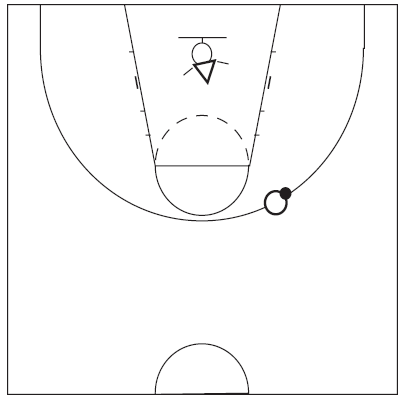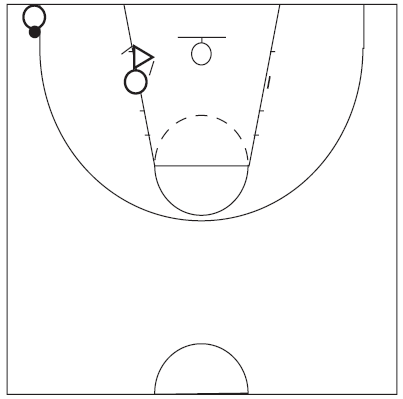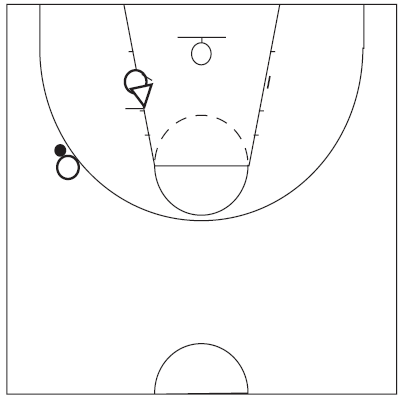One-on-One (1/1)
in the paint from the view of defensive player
For full player´s capacity we recommend practising defence of drives with all players. We divide basic defence posture according to position of defender to the basket into defence from behind of forward, from sides (high and low position) and front defence (facing or more often back to the forward). Prerequisite of precise defence is position of arms. First, we show actions methodology, which leads to successful mastery of defence.
Practise methodology:
- Basic stance – wide position of feet emphasis on body work in the moment of pressure from forward with ball
- Stance in the distance of bent arm from receiver which is back to the basket
- No reaction to backward pass fake
- An effort to hit uncovered forward´s ball (in the stabile posture or during dribbling to the paint when the forward is back to the basket)
- Shot after turnaround or back spin of forward connect with defensive rebound. During the turn arm against the shot with low gravity centre and immediate step to the forward – then defend according to the outside the paint defensive rules.
Exercise for defensive game development
- Position engagement in the paint – push the forward outside from advantageous position for following 1/1 (Fig. 60).

Fig. 60: Advantageous defender´s position
- Modification of offensive stance at the moment of pass in course of side-defence – defender´s stance according to ball position and rotation of player by turns (Fig. 61–63)

Fig. 61: Ball at the base line

Fig. 63: Ball at extended free throw line
- Defender´s actions at the moment of pass to player in low post – defender choose from two options – move to behind of forward at the distance of bend arm (Fig. 64), or jump in front the forward with aim to gain the ball (Fig. 65)
Fig. 64: Move behind to forward
Fig. 65: Jump in front of forward
- Defence of forward standing back to the basket in course of defence from the front; in this stage we consider necessary to name also activity of the other post player to complement context (Fig. 66, 67), It is necessary to put emphasis on defender´s move from player no. 5 to player no. 4, when switching of forwards happens and also on creating good position for rebound (Capel, 2005).
- Defender´s action at the weak side during player´s drive from perimeter in the paint
- In addition, we also show the option when pivotman according to defensive system stop the ball handler (Fig. 68) – emphasis on distance – it is ideal to help just at the edge of the paint, the wide base is important, also as arms up, harmonise the stance to the incoming defender of driving player, coach should say to which moment there is a help and which way player should go after the help.
Defence of 1/1 from the high-post
For the defence of player in high post we show methodology of activities, which leads to successful mastery of defence in high-post.
Practise methodology:
- Basic stance – wide position of feet, low stance, back straight every up extension leads to advantage for forward
- Defence of player during his cut to high post – defender tries to maintain stance between player and ball and not allow forward in good position for pass receiving. He must also keep his rear foot in position closer than the forward´s foot in order to prevent from lob pass or cut by turn.
- Ball play – holding of ball in front of body between knees and shoulders is a sigh for attempt to gain a ball (by both hands)
- Defend setting ball for shot in low-flexion of body put the arms duly up against the shot (left hand against right handed player)
- Not to get move by faking of forward – with use of slight changes in gravity centre from right to left foot and back – react only to movement connected with dribbling and choose optimal length of step with keeping level of gravity centre
- Defence according to rules (it often happen that defender catch forward by hands or with knees during the drive or tries to steal ball over the shoulder level)
- After shooting connect with defensive rebound
- When sprint to the player which already has a ball, shorten the distance by hand against the shot (in no case jump against the shot!) just that defender can catch possible drive by backward movement.
- When defending the post – shooter defender should choose tight defence and take a risk of forward´s cut to the basket
- When defending the player which prefers drives to the basket, choose standing back and taking risk of shod from middle distance.
- When defending the complex player defender should use tight man to man defence without ball and prevent from the pass
- During the forward´s drive initiate contact with forward´s body (by body centre if possible) with an aim to push the forward from good position for shot
- During the drive which goes against the closer defender´s leg, perform step in this way with an aim to reach the position sooner than forward (leads to charging and winning the ball)
- If forward makes a turn, defender should make backward defensive movement back to his own basket
- When forward make a lay-up choose block after adjustment of steps and turning of body – doing the same lay-up with attempt to hit the ball by closer hand (when shot from left side block by left hand – defender avoid personal foul
- Defensive actions starts with back step and follow with feet and body movement against the forward move and until that add in next stage work of body and arms.
Mgr. Tomáš Pětivlas, Ph.D. |
Faculty of Sports Studies of Masaryk University |
back to homepage, accessability |
Faculty of Sports Studies of Masaryk University |
back to homepage, accessability |
| Technical cooperation:
| Service Center for E-Learning
| The Faculty of Informatics, Masaryk University, 2011
| Service Center for E-Learning
| The Faculty of Informatics, Masaryk University, 2011
Technické řešení této výukové pomůcky je spolufinancováno Evropským sociálním fondem a státním rozpočtem České republiky.

